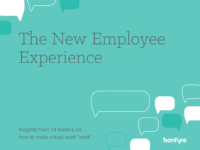As the de facto caretakers of company culture and employee engagement, HR professionals have their work cut out for them.
The contemporary American workplace can now have as many as five different generations working under the same roof. Developing tactics to not only effectively communicate but also engage each employee is no small task. Each generation has been shaped by starkly different historical circumstances, and comes with different understandings of their role in the workplace.
Before we discuss strategy on how to engage employees from all five, here’s a brief overview of each generation, with year divisions determined by Pew Research Center:
- Silent Generation (1928-1945): A small but no less important percentage of The Silent Generation remains in the workforce, primarily in executive positions and advisory roles.
- Baby Boomer (1946-1964): Baby boomers were once the backbone of the U.S. labor force but have since been surpassed by Gen X and millennials. Many are spending the waning days of their careers in mid to upper management positions.
- Gen X (1965-1980): Many of the current and rising leaders in today’s workplace are from Gen X. Although skilled and strong workers in their own right, Gen X pushed back against the boomers to advocate for a strong work/life balance.
- Millennial (1981-1997): Millennials currently make up the largest portion of the working population, a majority that is expected to dramatically increase in the coming years. This generation entered the workforce at the same time that technology disrupted traditional work environments, and the willingness and savvy with which they embraced these new tools gave older generations pause.
- Gen Z (1998-Present): Gen Z, the most diverse generation in U.S. history, is only now beginning to enter the workforce. Research on this generation is limited thus far, but early observations suggest Gen Z’s attitudes are a blend of the previous generations.
How to engage employees from every generation.
The first step to crafting your engagement strategy is to step back and remember your workforce is made up of people—not abstract generational categories. If you build your approach relying solely on insights from literature about millennials or boomers or Gen X, you won’t have a strategy truly tailored to the needs of your workforce. What you’ll get instead is a strategy catering to someone else’s idea of what they think your workforce is like.
Related: What to Expect When You're Expecting Gen Z
The only way to receive truly actionable information about your employee population is through two-way communication. After all, the majority of your millennial workers might be more receptive to engagement methods tailored to Gen X, but you’ll never know if you don’t ask.
This change starts when company leadership makes themselves available to employees, connect with workers personally and build professional relationships. Generational cohorts may have different work preferences, but the need to belong is a universal human desire and strong work relationships are the secret to a highly-engaged workforce.
It simply isn’t scalable for the CEO of a company with thousands of employees to meet with everyone individually. Managers need to do their part and connect with their corresponding teams. The end goal is to clear the channels of communication across every layer of an organization so that information flows freely from top to bottom.
When the time comes to evaluate how and why an organization needs to change, middle level managers need to be informed so they can accurately represent the needs of their lower level employees. If there’s a breakdown in communication, you’ll never receive the information that you need and real change can never occur.
Beyond a strong emphasis on communication and relationships, consider prioritizing the following when crafting your cross-generational engagement approach:
1. Align your organization
From an engagement standpoint, it is a requirement that a company is aligned on its purpose. You need to know what you’re setting out to achieve before you can craft your approach. Regardless of the environment you’re trying to build, cohesion must be at the heart of your efforts. If everyone—executives, managers, even ground-level employees—is not working toward the same endpoint, your strategy won’t be as successful as you want.
2. Design for flexibility
Be flexible in thought and in the systems you implement. Forty years ago, it was easy for leadership to design programs that appealed to the largely homogenous workforce. Today, however, that approach is less successful, especially considering preferences can conflict between generations. Invest in stable systems, but allow them to house flexible framework. For example, more options when it comes to work schedules, office space arrangements, and benefits offerings have a better chance of engaging this more diverse work population.
3. Avoid stereotypes and biases
When we view people as categories, we create stereotypes and biases that result in unfair and inaccurate views of individuals. You can actively combat this bias formation by implementing cross-generational teams wherever possible. Nothing good comes from keeping separate from one another. Create opportunities for these generations to interact and work together. Not only do coworkers learn more from each other than formal training programs, cross-generational teams can provide the foundation for powerful mentor-mentee relationships.
4. Promote diversity of thought
Diversity doesn’t start and stop with your hiring practices. Inclusivity needs to underscore every interaction you have with your workforce. Cultivate an environment that promotes diversity of thought through widespread recognition practices. Don’t just focus on the most obvious top-performers. Make sure to shine the spotlight on all segments of your workforce across every generation. Recognition is a powerful motivator, and robust practices make everyone feel valued.
Looking forward, it’s important for HR managers to understand that change is inevitable. Engagement strategies need to accommodate the generations of tomorrow as well as those of today. If you build programs with too much investment towards today’s generations, you’ll be ill-equipped to engage emerging generations. Ultimately the systems that endure will be those focused on the needs of humans instead of categories.


 4 min
4 min




